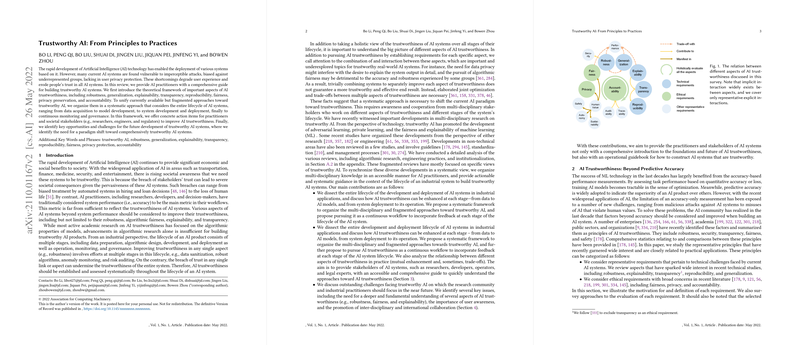Overview of "Trustworthy AI: From Principles to Practices"
This paper, authored by Bo Li et al., offers a comprehensive review of the principles and practices necessary for the development of trustworthy AI systems. It addresses the multifaceted challenges facing current AI technologies, such as vulnerabilities to attacks, bias, user privacy concerns, and the erosion of public trust in AI. The paper provides both a theoretical framework and a systematic approach to creating trustworthy AI systems that serve the interests of AI practitioners, engineers, researchers, and regulators.
Key Aspects of AI Trustworthiness
The authors detail key dimensions of AI trustworthiness, including robustness, generalization, explainability, transparency, reproducibility, fairness, privacy preservation, and accountability. Each of these aspects is critical to establishing and maintaining trust in AI systems across their entire lifecycle, from data acquisition through to system development, deployment, and ongoing governance.
A Lifecycle Approach to Trustworthy AI
The paper suggests a systematic lifecycle approach, covering key stages such as data preparation, algorithm design, system development, deployment, and continuous monitoring. For each stage, the authors propose actionable steps that practitioners can take to enhance AI trustworthiness.
- Data Preparation:
- Emphasizes bias mitigation and data provenance in data collection and preprocessing.
- Discusses anomaly detection and data anonymization techniques to ensure data privacy and integrity.
- Algorithm Design:
- Focuses on adversarial robustness with methods like adversarial training and regularization.
- Covers generalization techniques to maintain performance across diverse environments and tasks.
- Discusses explainable AI models and post-hoc explanation techniques.
- Reviews fairness through pre-processing, in-processing, and post-processing bias mitigation techniques.
- Considers privacy-preserving computational frameworks like SMPC and federated learning.
- Development and Deployment:
- Explores testing, simulation, and benchmarking methodologies to ensure system reliability.
- Describes human-AI interactions, anomaly monitoring, and fail-safe mechanisms to enhance operational trustworthiness.
- Addresses security challenges specific to hardware deployments.
- Management and Governance:
- Advocates for comprehensive documentation to support transparency and accountability.
- Highlights the importance of auditing practices for internal and external validation of AI systems.
- Encourages cross-disciplinary and international cooperation for creating standards and sharing incidents.
Challenges and Opportunities
The authors point out the immaturity of many current approaches to AI trustworthiness, highlighting areas such as explainability and adversarial robustness where research is ongoing and solutions are still evolving. They note potential trade-offs between different trustworthiness dimensions, such as the impact of transparency on privacy and the interplay between robustness and fairness.
The paper also underscores the necessity of considering trustworthiness as a dynamic, continuous process rather than a one-time goal. It calls for the incorporation of AI principles into daily operations through workflows that support iterative improvement and stakeholder alignment, emphasizing the role of TrustAIOps in achieving these objectives.
Conclusion
In conclusion, the research proposes a paradigm shift toward trust-driven AI systems, moving beyond performance-centric metrics to incorporate broader societal values and ethical considerations. This approach requires active cooperation among stakeholders, including AI researchers, engineers, policymakers, and end-users. By addressing these complex challenges, the development and deployment of trustworthy AI systems can be better aligned with the interests and needs of society. The paper provides a framework and actionable insights intended to guide practitioners in building more accountable, fair, and robust AI technologies.
